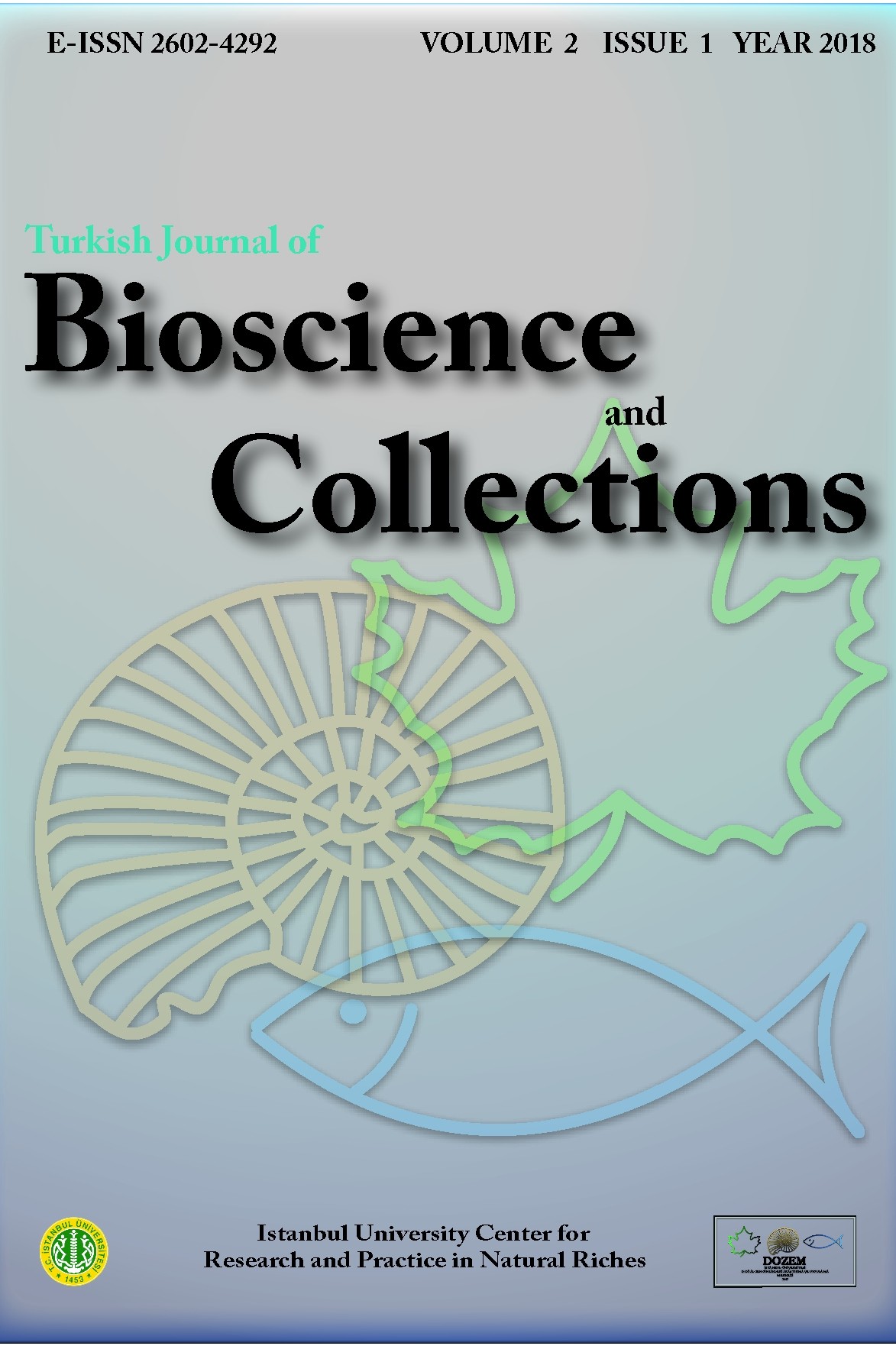Biyoçeşitlilik Koleksiyonlarının Dijitalleştirilmesi ve Aydınlatma Kabini Tasarımı
Amaç: Biyoçeşitlilik koleksiyonlarında ve müzelerinde milyonlarca numune bulunmaktadır. Koleksiyonlardaki bu numunelerin dijital veriye dönüştürülmesi son çeyrek yüzyılda başlamış ve hızla artmıştır. Bu süreç müzelerin dijital numunelerini oluşturmasına neden olmuştur. Bu çalışmada ülkemizde var olan biyoçeşitlilik koleksiyonlarının dijitalleştirilmesi ve farklı koleksiyonlar ile birleştirilerek açık ulaşıma sunulmasında kullanılabilecek dijital fotoğraf çekimini basit yöntemlere kavuşturmak ve veri setlerinin oluşturulmasında standartlaşmayı sağlamak amaçlanmıştır. Materyal ve Yöntem: Çalışmada ESOGÜ Zooloji Müzesi koleksiyonunda yer alan omurgalı ve omurgasız hayvanlara ait numunelerin dijital görsellerinin alınması ve veri setleri oluşturulması sürecinde kullanılan yöntemler paylaşılmaktadır. Numunelerin dijital görsellerinin alınması için 60 × 60 cm ölçülerinde 40 W LED panellerden oluşan bir aydınlatma kabini tasarımı yapılmış ve kullanılmıştır. Bulgular: Çalışmada biyoçeşitliliğe ait numunelerinin envanterlerinin oluşturulması için kullanılacak standart altı harf ve altı sayıdan oluşan bir kayıt kodu, sergilenen numuneler için üç farklı numune veri etiketi tasarlanmıştır. Tüm dijital görsellerin sayısal ortamda arşivlenebilmesinde kullanılacak adlandırma kuralı oluşturulmuştur. Sonuç: Tasarımı yapılan ışıklandırma kabininin farklı hayvansal müze numunelerinde kullanımı ile ilgili bilgiler verilmiş ve sonuçlar paylaşılmıştır.
Anahtar Kelimeler:
Anadolu, biyofotografi, doğa tarihi, veri kaydı
Digitization of Biodiversity Collections and a Lighting Cabinet Design
Objective: There are millions of specimens in biodiversity collections and museums. The conversion of these specimens in collections to digital data started in the last quarter century and has increased rapidly. This process has caused museums to create digital specimens. In this study, it is aimed to simplify digital photography and to standardize the creation of data sets in digitizing the existing biodiversity collections in our country and to present them to open access by combining them with different collections. Materials and Methods: In the study, the methods used for obtaining digital images of vertebrate and invertebrate animals in the collection of the ESOGÜ Zoology Museum and creating data sets are shared. A lighting cabinet consisting of 60 × 60 cm 40 W LED panels was designed and used to take the digital images of the samples. Results: A registration code of six letters and six numbers, which will be used to create inventories of biodiversity samples, and three different sample data labels for the exhibited samples were designed in the study. A naming rule has been established for archiving all digital images in a digital environment. Conclusion: Information on using the designed lighting cabinet in different animal museum specimens is provided and the results are shared.
Keywords:
Anatolia, biophotography, data record, natural history,
___
- Arino, A. H. & Galicia, D. (2005). Taxonomic-Grade İmages. İn C. L. Hauser, A. Steiner, J. Holstein, & M. J. Scoble (Eds.), Digital Imaging of Biological Type Specimens. A Manual of Best Practice. Results from a study of the European Network for Biodiversity Information, (pp. 87-125). Stuttgart. google scholar
- Crick, M. (2005). İmage file management. İn C. L. Hauser, A. Steiner, J. Holstein, & M. J. Scoble (Eds.), Digital Imaging of Biological Type Specimens. A Manual of Best Practice, (pp. 41-55). Stuttgart. google scholar
- Doerr, M., Stead, S. & Theodoridou, M. (2016). Definition of the CRMdig an extension of CİDOC-CRM to support provenance metadata. White Paper, Erişim: https://cidoc-crm.org/ crmdig/sites/default/files/CRMdig_v3.2.1.pdf (Erişim tarihi: 20.06.2023) google scholar
- Global Biodiversity Information Facility (GBIF), Erişim: https:// www.gbif.org/ (Erişim tarihi. 07.06.2023) google scholar
- Hauser, C.L., Holstein, J. & Steiner, A. (2005). Digital Imaging of Butterflies and Other Lepidoptera More or less “flat” objects? In C. L. Hauser, A. Steiner, J. Holstein, & M. J. Scoble (Eds.), Digital Imaging of Biological Type Specimens. A Manual of Best Practice. Results from a study of the European Network for Biodiversity Information, (pp 251-264). Stuttgart. google scholar
- Hui, Y. (2012). What is a digital object? Metaphilosophy, 43(4), 380-395. https://doi.org/10.1111/j.1467-9973.2012.01761.x google scholar
- Hui, Y. (2016). On the Existence of Digital Objects. Minneapolis, MN: University of Minnesota Press. google scholar
- Meehan, N. (2022). Digital museum objects and memory: Postdigital materiality, aura and value. Curator The Museum Journal, 65(2), 417-434. https://doi.org/10.1111/cura.12361 google scholar
- Nelson, G. & Ellis, S. (2018). The history and impact of digitization and digital data mobilization on biodiversity research. Philosophical Transactions Royal Society B 374, 20170391. http://dx.doi.org/10.1098/rstb.2017.0391 google scholar
- Nichols C. A. (2021). Illustrating anthropological knowledge: texts, images and duplicate specimens at the Smithsonian Institution and Pitt Rivers Museum. In F. Driver, M. Nesbitt & C. Cornish, (Eds.), Mobile Museums: Collections in circulation (pp 121148). UCL Press. https://doi.org/10.2307/j.ctv18kc0px.12 google scholar
- Riedel, A. (2005). Digital imaging of beetles (Coleoptera) and other three-dimensional insects. In C. L. Hauser, A. Steiner, J. Holstein, & M. J. Scoble (Eds.), Digital Imaging of Biological Type Specimens. A Manual of Best Practice. Results from a study of the European Network for Biodiversity Information, (pp 222-250). Stuttgart. google scholar
- Speers, L. (2005). E-Types - A new resource for taxomic resarch. In C. L. Hauser, A. Steiner, J. Holstein, & M. J. Scoble (Eds.), Digital Imaging of Biological Type Specimens. A Manual of Best Practice. Results from a study of the European Network for Biodiversity Information, (pp 13-18). Stuttgart. google scholar
- Yayın Aralığı: Yılda 2 Sayı
- Başlangıç: 2017
- Yayıncı: İstanbul Üniversitesi
Sayıdaki Diğer Makaleler
Deniz ERGÜDEN, Servet Ahmet DOĞDU, Cemal TURAN
Fulgence Ntangere MPENDA, Cyprian Beda MPİNDA, Simeon Phares NSİNDAGİ
Evaluation of Siamese Twins of Testudo graeca Linnaeus, 1758
Ayfer ŞİRİN, Serdar DÜŞEN, Eyup BAŞKALE
Biyoçeşitlilik Koleksiyonlarının Dijitalleştirilmesi ve Aydınlatma Kabini Tasarımı
Hakan CALISKAN, Hatice Kübra YALÇIN
Ömer YÜZER, Ersin DOĞAÇ, Alper TONGUÇ, Evin GÜNENÇ
Taylan DOĞAROĞLU, Evin GÜNENÇ, Rumeysa Yeşim MANAP, Vatan TAŞKIN, Belgin GÖÇMEN TAŞKIN, Ersin DOĞAÇ
